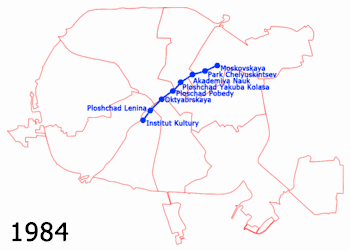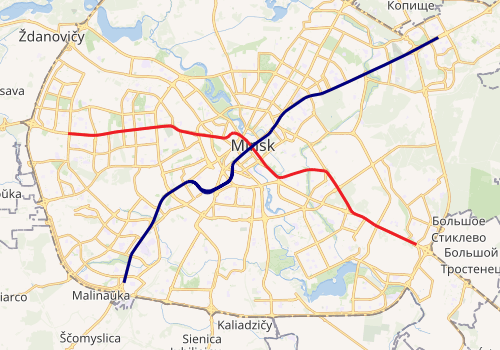Minsk Metro
The Minsk Metro (Belarusian: Мінскі метрапалітэн, Russian: Минский метрополитен) is a rapid transit system that serves Minsk, the capital of Belarus. Opened in 1984,[2] it presently consists of 2 lines[1] and 29 stations,[1] totaling 37.27 kilometres (23.16 mi).[1] In 2013, the system carried 328.3 million passengers,[3] which averages to a daily ridership of approximately 899,450.
 | |||
| Overview | |||
|---|---|---|---|
| Native name |
| ||
| Owner | State ownership | ||
| Locale | Minsk, Belarus | ||
| Transit type | Rapid transit | ||
| Number of lines | 2[1] | ||
| Number of stations | 29[1] | ||
| Daily ridership | 872,700 (2014)[1] | ||
| Annual ridership | 318.5 million (2014)[1] | ||
| Website | metropoliten | ||
| Operation | |||
| Began operation | 30 June 1984[2] | ||
| Operator(s) | Минский Метрополитен [Minsk Metro] | ||
| Number of vehicles | 361[1] | ||
| Technical | |||
| System length | 37.3 km (23.2 mi)[1] | ||
| Track gauge | 1,524 mm (5 ft) | ||
| Average speed | 41 km/h (25 mph)[1] | ||
| |||

History
During the 1950s–1970s the population of the city soared over a million and designs for a rapid transit system were initially put up during the late 1960s. Construction began on 3 May 1977, and the system was opened to the public on 30 June 1984, becoming the ninth metro system in the Soviet Union.[2] The original eight station section has since expanded into a two-line 29 station network with 37.27 kilometres (23.16 mi) of route.[1]
Despite the dissolution of the Soviet Union the construction of Minsk metro continued uninterrupted throughout the 1990s (as opposed to other ex-Soviet Metros like those of Yerevan and Samara, which were halted due to a complete lack of funding). Some experts attribute it to the slow reform of the Soviet planned economy in Belarus, which turned out to be beneficial for the metro expansion. Currently, station launch dates are ahead of original schedule. For example, the final phase of the Aŭtazavodskaja Line, originally planned for 2006, was opened in late 2005, and similarly the northern extension of the Maskoŭskaja Line, originally scheduled for 2008, opened on 7 November 2007.[4] There were also 3 new stations opened on the southern end of the Maskoŭskaja line in November 2012.
Timeline
| Segment | Line | Date opened |
|---|---|---|
| Instytut Kultury–Maskoŭskaja | Maskowskaya | 30 June 1984 |
| Maskoŭskaja–Uschod | Maskowskaya | 30 December 1986 |
| Traktarny zavod–Frunzyenskaya | Awtazavodskaya | 31 December 1990 |
| Pyershamayskaya | Awtazavodskaya | 1991 |
| Frunzyenskaya–Pushkinskaya | Awtazavodskaya | 3 July 1995 |
| Traktarny zavod–Awtazavodskaya | Awtazavodskaya | 7 November 1997 |
| Awtazavodskaya–Mahilyowskaya | Awtazavodskaya | 5 September 2001 |
| Pushkinskaya–Kamyennaya Horka | Awtazavodskaya | 7 November 2005 |
| Uschod–Uručča | Maskowskaya | 7 November 2007 |
| Instytut Kultury–Pyatrowshchyna | Maskowskaya | 7 November 2012 |
| Pyatrowshchyna–Malinawka | Maskowskaya | 3 June 2014 |
Operational characteristics
The city is located on an almost level surface and on very dry soils. As a result, although all of the Minsk Metro stations are under the surface, there are no deep-level stations that are found in most of the ex-Soviet cities.[5] Out of the current 29 stations[5] 19 are pillar-spans and 10 are of vaulted type. Like most of the Soviet metro systems, all of the stations are vividly decorated. Some (notably, Niamiha) exhibit Belarusian national motifs, others focus on more Soviet socialist themes. Although recent years saw more priority on high-tech decorations.
Expansion plans

At present, there are several projects, only one of which is under construction, the southwestern extension of the Maskowskaya line to the new residential districts in the south-west of the city. This project is fully complete, with 3 out of 4 stations opened November 2012, with Malinawka the final station, opened June 2014. The Maskowskaya and Awtazavodskaya lines can potentially receive an extension on both ends of each line.
However, the major project after 2013 will be a third line running from the south to the north-east of the city via the centre, creating two new transfer points with the existing lines. The construction of the third line was expected to start in 2011, delayed to late 2013, and the first stage of the line is expected to open in 2020[6]. This would follow a northern contour parallel to Maskowskaya, and relieve the extensive congestion in the city area, and then extend south of the city.
A fourth line is not expected to be built before 2020. It is expected to connect south-eastern parts of the city with the north-western residential areas.
Incidents
1999 stampede
On 30 May 1999, a sudden thunderstorm caused a large crowd, from a nearby rock concert, to seek shelter at the Nyamiha station. The limited size of the subways leading into the ticket hall and the wet pavement caused a human crush. Fifty-three people died.
2011 bombing
The Kastrychnitskaya station was the site of a terrorist bombing on 11 April 2011. Fifteen people were killed.
Lines and stations
| # | Name (Belarusian Latin/Cyrillic) | Opened | Length | Stations |
|---|---|---|---|---|
| 1 | Maskowskaya (Маскоўская) | 1984[2] | 19.1 km | 15[1] |
| 2 | Awtazavodskaya (Аўтазаводская) | 1990[2] | 18.1 km | 14[1] |
| Total | 37.3 km[1] | 29[1] |
Map

Maskoŭskaja line
 Plošča Jakuba Kolasa
Plošča Jakuba Kolasa- Akademija navuk
 Park Čaliuskincaŭ
Park Čaliuskincaŭ Maskoŭskaja
Maskoŭskaja Uschod
Uschod Barysaŭski trakt
Barysaŭski trakt Uručča
Uručča
Aŭtazavodskaja line
 Kamiennaja Horka
Kamiennaja Horka Kuncaŭščyna
Kuncaŭščyna Spartyŭnaja
Spartyŭnaja Puškinskaja
Puškinskaja Maladziožnaja
Maladziožnaja Frunzienskaja
Frunzienskaja
See also
References
- Метро сегодня [Metro today] (in Russian). Государственное предприятие "Минский Метрополитен" [State Enterprise "Minsk Metro"]. 2014. Retrieved 27 June 2015.
- История развития метрополитена [History of the metro]. Государственное предприятие "Минский Метрополитен" [State Enterprise "Minsk Metro"]. 2014. Retrieved 27 June 2015.
- ОСНОВНЫЕ ТЕХНИКО-ЭКСПЛУАТАЦИОННЫЕ ХАРАКТЕРИСТИКИ МЕТРОПОЛИТЕНОВ ЗА 2013 ГОД. [Main technical and operational specifications for Subways for Year 2013.] (pdf). asmetro.ru (in Russian). Международная Ассоциация "Метро" [International Association of Metros]. 2013. p. 3. Retrieved 13 May 2014.
- "City News in Brief". Railway Gazette International. 11 December 2007.
- "Minsk metro | Belarus.by". www.belarus.by.
- 4 stations of 3rd line of Minsk metro to be opened for passengers in 2020
External links
| Wikimedia Commons has media related to Minsk Metro. |
- Minsk Metro Map on Google Maps
- Minsk Metro – official site
- Official City of Minsk Urban Transport site
- The site of the Minsk subway Minsk-Metro.NET (unofficial)
- Minsk at UrbanRail.net
- Site by Andrey Kharchevk
- Popular site
- Another Popular site
- Network map
- Minsk Metro Track Map

